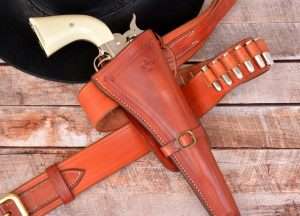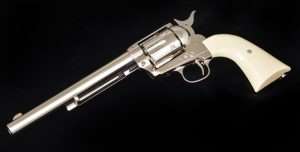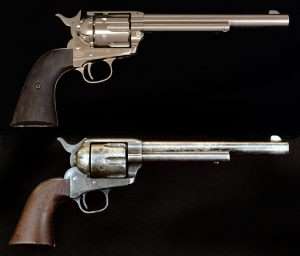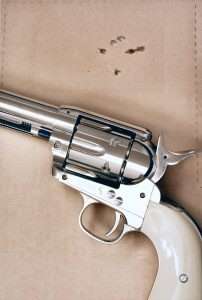Recreating the Original Single Action Army in 4.5mm caliber
Vincit qui patitur, “He conquers who suffers.” – Samuel Colt

Although Samuel Colt had patented the first successful single action revolver in 1835 and been responsible for the greatest percussion revolvers of the mid 19th Century, he would have no part in creating his final legacy, the most enduring Colt revolver of all time, the 1873 “New Model Army Metallic Cartridge Revolving Pistol” better known today as the Colt Peacemaker.

Designed by William Mason, the new .45 Colt revolver was known by several names, Frontier Six-Shooter, Peacemaker, and Single Action Army or the military’s often used contraction SAA, but no matter what name was used, the new Colt was destined to become the most successful and longest-lived design in firearms history. It has survived and remained in production by the Colt’s Patent Firearms Company in a variety of models and calibers for an amazing 143 years!

William Mason had received his patent for the Peacemaker on September 19, 1871. A second patent was issued on July 2, 1872 and a third on January 19, 1875. To this day, these dates are still stamped on the left side of the frame. Almost all of the first deliveries of the SAA were to the U.S. military, and the government continued to order the new revolvers until 1891, accounting for some 37,000 guns, with another 107,000 produced for the civilian market from 1874 to 1891. By the turn of the century Colt’s had sold more than 192,000 Peacemakers.
Over the past 143 years since Single Action Army manufacturing began, there have been very few changes to the fundamentals of the William Mason design. One of the most notable was the way in which the cylinder arbor was retained. The original SAA, now referred to as the “black powder frame” used a retaining screw in the bottom front of the frame to lock the cylinder arbor in place. Removing this screw was necessary when cleaning the Peacemaker, in order to take the cylinder out of the frame. Beginning in 1892 the retaining screw was replaced by a transverse cylinder latch in the side of the frame, just below the barrel, which simply needed to be depressed in order to release the cylinder arbor and allow it to slide out. This was arbitrarily called the “smokeless powder frame” version, although Colt’s did not guarantee their revolvers against smokeless powder until 1900. This later transverse latch design is the version used by Umarex to build its groundbreaking .177 caliber models introduced in 2015, and the latest nickel plated 7-1/2 inch barrel length pellet models.

The Significance of the 7-1/2 inch Peacemaker
The very first Colt Peacemaker, serial number 1 had a 7-1/2 barrel, all of the original Single Action Army models issued to the U.S. Cavalry and Army were 7-1/2 inch barrel lengths. The 7-1/2 inch barrel length was also preferred by the vast majority of early SAA owners, particularly lawmen, even when Colt’s began offering shorter barrel lengths of 4-3/4 inches and 5-1/2 inches in 1875. The 7-1/2 inch model Peacemaker was Colt’s premier revolver. In 1877, the blued finish was replaced by nickel plating as the model’s standard finish, with the original blued finish with color cased frame and hammer an optional choice.

Compared to a .45 Colt, the Umarex measures up with the same external barrel length of 7-1/2 inches (measured from the front of the cylinder to the muzzle), same frame height of 2-1/2 inches, and comes in a hair lighter at 36 ounces compared to an average of 40 ounces for 7-1/2 inch barrel length .45 Colt Peacemakers.


Putting Lead Downrange
As this is the first 7-1/2 inch model from Umarex, the expectations for slightly greater pellet velocity and accuracy than the 5-1/2 inch models is high, and I headed down to the target range with Umarex 12 gram CO2, Meisterkugeln Professional Line 7.0 gr. lead wadcutter pellets and a dozen of the airgun’s silver pellet cartridges.


For the test, an IPSC cardboard silhouette target was set out at a distance of 25 feet and all shots were fired using a two-handed hold for best offhand stability. The results were as satisfying as handling this remarkably authentic 7-1/2 inch Colt CO2 Peacemaker. The Meisterkugeln wadcutters cleared the long barrel at an average velocity of 416 fps, and the best six-round group measured 1.25 inches in the A-Zone of the IPSC target. In terms of loading, handling, balance in the hand and sighting, everything about the new Umarex Colt 7-1/2 inch model is pretty darn real, right up to the moment the hammer drops.
The Peacemaker has been built by Colt’s longer than any other revolver manufactured anywhere in the world, and remains to this day the indisputable icon of the American West. The new 7-1/2 inch nickel plated 4.5mm pellet models add to that ongoing history in ways that even William Mason couldn’t have imagined!
A Word About Safety
Single Action airguns provide the look, feel and operation of their cartridge-firing counterparts and this is one reason why they have become so popular. Airguns in general all look like guns, the Colt Peacemakers more so, and it is important to remember that the vast majority of people can’t tell an airgun from a cartridge gun. Never brandish an airgun in public. Always, and I can never stress this enough, always treat an airgun as you would a cartridge gun. The same manual of operation and safety should always apply.


Glad to see that the long tube does pick up velocity . As you noted , the SAA is still in production at Colt ,in limited numbers .Colt , a shadow of its former self produced no other revolvers . Fortunately the Umarex is affordable and available.Hope to see the short barreled versions.Wonder how much poor eyesight in the old west had to do with the long barrels .